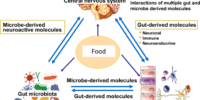Food Intolerances And Sensitivities: Identifying Triggers And Managing Symptoms
Food intolerances and sensitivities can be challenging to identify and manage.
Many individuals experience adverse reactions to certain foods, but understanding the difference between food intolerances and sensitivities is crucial.
Food intolerances occur when the body lacks the necessary enzymes to properly digest certain substances, such as lactose or gluten.
On the other hand, food sensitivities involve an immune response to specific components in food, leading to a range of symptoms.
Identifying triggers for food intolerances and sensitivities is essential in order to effectively manage symptoms.
This can be achieved through keeping a food diary to track reactions and identifying patterns.
Additionally, an elimination diet can be implemented to determine which foods may be causing adverse reactions.
Seeking medical testing and professional help can also provide valuable insights into specific triggers and appropriate management strategies.
Understanding cross-reactivity and hidden ingredients is crucial, as certain foods and ingredients may cause reactions even if they are not directly consumed.
By employing strategies for managing symptoms on a daily basis and exploring alternative food options and substitutions, individuals can find relief and enhance their overall well-being.
Additionally, prioritizing self-care and emotional well-being is essential in coping with the challenges associated with food intolerances and sensitivities.
Key Takeaways
- Cross-reactivity between different foods can occur in individuals with food intolerances or sensitivities, leading to similar allergic reactions.
- Hidden ingredients in packaged and processed foods, such as gluten and dairy derivatives, can pose challenges for those managing food intolerances or sensitivities.
- Strategies like maintaining a strict elimination diet and keeping a food diary can help individuals identify trigger foods and manage their symptoms effectively.
- Seeking guidance from healthcare professionals like dietitians or allergists and exploring alternative food options are essential for proper nutrient intake and emotional well-being.
Understand the Difference Between Food Intolerances and Sensitivities
Food intolerances and sensitivities can be distinguished by the body’s response to specific food components, with intolerances involving the inability to properly digest certain substances and sensitivities referring to adverse reactions triggered by the immune system.
Food intolerances occur when the body lacks the necessary enzymes to break down certain components in food, such as lactose or gluten. This can lead to digestive symptoms such as bloating, diarrhea, or abdominal pain.
In contrast, food sensitivities involve the immune system’s reaction to specific proteins in food, causing symptoms such as skin rashes, headaches, or nasal congestion.
The mechanisms behind food intolerances and sensitivities are different. Food intolerances typically involve the lack of a specific enzyme needed to digest a particular substance. For example, lactose intolerance occurs when the body does not produce enough lactase, the enzyme responsible for breaking down lactose, the sugar found in milk and dairy products. Without enough lactase, lactose cannot be properly digested, leading to digestive symptoms.
On the other hand, food sensitivities are triggered by the immune system’s response to certain proteins in food. When these proteins are ingested, the immune system mistakenly identifies them as harmful and releases chemicals such as histamine, leading to allergic reactions.
Food intolerances and sensitivities differ in terms of their underlying mechanisms and symptoms. Intolerances involve the body’s inability to properly digest certain substances, while sensitivities refer to adverse immune reactions triggered by specific food proteins.
Understanding the difference between these two conditions is crucial for accurate diagnosis and appropriate management of symptoms.
Common Symptoms of Food Intolerances and Sensitivities
Gastrointestinal discomfort, skin rashes, and respiratory symptoms are some commonly experienced indicators of adverse reactions to certain food components.
Food intolerances and sensitivities can manifest in a variety of ways, making it difficult to identify the specific trigger.
Gastrointestinal discomfort is one of the most common symptoms, which can include bloating, gas, abdominal pain, and diarrhea. These symptoms are often caused by the body’s inability to properly digest certain food components, such as lactose or gluten.
Skin rashes are another common symptom of food intolerances and sensitivities. These rashes can range from mild irritation to more severe conditions such as eczema or hives. The exact cause of these skin reactions can vary, but they are often triggered by an immune response to certain food components.
In some cases, respiratory symptoms may also be present. These can include nasal congestion, sneezing, coughing, or wheezing. These symptoms are often associated with an allergic reaction to specific food components, such as peanuts or shellfish.
Overall, the symptoms of food intolerances and sensitivities can vary widely from person to person. It is important to be aware of these common indicators in order to identify potential triggers and manage symptoms effectively.
Keep a Food Diary to Track Your Reactions
Keeping a detailed record of your daily meals and any subsequent reactions can help identify patterns and potential triggers for adverse food reactions. By maintaining a food diary, individuals can track what they eat and any symptoms they experience afterwards, allowing them to establish a cause-and-effect relationship between specific foods and their reactions.
This record can be a valuable tool in identifying food intolerances and sensitivities, as it provides a comprehensive overview of an individual’s dietary habits and associated symptoms.
In a food diary, individuals should record not only the foods they consume but also the portion sizes, cooking methods, and any other relevant details. It is important to be as specific as possible in documenting both the food and the reaction experienced. Symptoms to look out for may include bloating, diarrhea, abdominal pain, skin rashes, headaches, or any other physical or emotional discomfort.
Additionally, noting the time of each meal and the onset of symptoms can help identify any potential patterns or delayed reactions. By diligently maintaining a food diary, individuals can better understand their body’s response to different foods and identify potential triggers, which can then inform dietary modifications and symptom management strategies.
Elimination Diet: Identifying Trigger Foods
The elimination diet involves systematically removing potential trigger foods from one’s diet in order to identify the specific items that may be causing adverse reactions.
This process is often recommended for individuals with food intolerances or sensitivities, as it helps to pinpoint the specific foods that are causing symptoms such as bloating, diarrhea, or skin rashes.
The elimination diet typically involves three main steps:
-
Elimination phase: During this phase, individuals remove all potential trigger foods from their diet. This may include common allergens such as dairy, gluten, soy, eggs, and nuts. The duration of the elimination phase can vary, but it is typically recommended to eliminate these foods for at least two to four weeks.
-
Reintroduction phase: After the elimination phase, individuals gradually reintroduce the eliminated foods back into their diet, one at a time. This allows them to observe any adverse reactions or symptoms that may occur. It is important to reintroduce the foods in a systematic manner, with a waiting period of several days between each new food, to accurately identify the trigger foods.
-
Maintenance phase: Once the trigger foods have been identified, individuals can enter the maintenance phase where they continue to avoid these specific foods in order to manage their symptoms.
It is important to note that the elimination diet should be done under the guidance of a healthcare professional, such as a registered dietitian, to ensure that the individual’s nutritional needs are being met and to provide support throughout the process.
Seek Medical Testing and Professional Help
Medical testing and seeking professional help are crucial steps in understanding and addressing potential underlying causes of adverse reactions to certain foods.
When experiencing symptoms of food intolerances or sensitivities, it is important to consult with a healthcare professional who specializes in this area. They can conduct specific tests to identify potential trigger foods and provide guidance on managing symptoms.
One common medical test used to identify food intolerances is the food allergy panel, which involves blood tests to measure the levels of specific antibodies produced in response to certain foods.
Another test is the elimination-challenge method, where suspected trigger foods are eliminated from the diet for a period of time and then gradually reintroduced to see if symptoms reoccur.
These tests can help determine which foods are causing adverse reactions and guide the individual in making necessary dietary changes.
Seeking professional help is also beneficial as healthcare professionals can provide personalized advice and support throughout the process, ensuring that the individual receives accurate information and effective strategies for managing their food intolerances or sensitivities.
Learn About Cross-Reactivity and Hidden Ingredients
To effectively manage food intolerances and sensitivities, it is crucial to seek medical testing and professional help. However, understanding the concept of cross-reactivity and hidden ingredients is equally important. Cross-reactivity occurs when the body reacts to similar proteins found in different foods. For example, individuals with a sensitivity to gluten may also experience symptoms when consuming foods that contain similar proteins, such as rye or barley. By learning about cross-reactivity, individuals can identify potential triggers and make informed choices about their diet.
Hidden ingredients can also pose challenges for those with food intolerances and sensitivities. Many packaged and processed foods contain hidden ingredients that may not be obvious to consumers. For instance, certain products may contain gluten or dairy derivatives that are not clearly labeled. This can make it difficult for individuals to avoid triggering foods, leading to ongoing symptoms and discomfort. By familiarizing themselves with common hidden ingredients and reading food labels carefully, individuals can mitigate the risk of inadvertently consuming trigger foods.
In order to further emphasize the importance of understanding cross-reactivity and hidden ingredients, the following table presents a comparison of symptoms and potential hidden ingredients for three common food intolerances: gluten, lactose, and histamine. This table serves as a visual representation of the potential impact that cross-reactivity and hidden ingredients can have on individuals with food intolerances and sensitivities.
| Food Intolerance | Symptoms | Potential Hidden Ingredients |
|---|---|---|
| Gluten | Abdominal pain, bloating, diarrhea | Soy sauce, malt vinegar, modified food starch |
| Lactose | Gas, bloating, diarrhea | Whey, casein, powdered milk |
| Histamine | Headaches, hives, nasal congestion | Cured meats, aged cheeses, fermented foods |
By understanding cross-reactivity and hidden ingredients, individuals can make more informed choices about their diet and reduce the risk of triggering symptoms. This knowledge empowers individuals to take control of their health and effectively manage their food intolerances and sensitivities.
Strategies for Managing Symptoms on a Daily Basis
One effective approach to alleviate the adverse effects of food intolerances and sensitivities is to implement various strategies that can help individuals cope with their symptoms on a daily basis.
One strategy is to maintain a strict elimination diet, which involves avoiding all known trigger foods and ingredients. This requires careful reading of food labels and being aware of cross-contamination risks.
Another strategy is to keep a food diary, recording everything consumed and any associated symptoms. This can help identify patterns and specific trigger foods.
Additionally, individuals can seek guidance from healthcare professionals, such as dietitians or allergists, who can provide personalized advice and support.
Another strategy for managing symptoms is to ensure proper nutrient intake despite dietary restrictions. This can be achieved by working with a registered dietitian to develop a balanced meal plan that includes alternative sources of nutrients found in common trigger foods.
For example, if dairy is a trigger, the dietitian can recommend calcium-rich alternatives like fortified plant-based milks or leafy greens.
Additionally, individuals may find it helpful to incorporate stress management techniques into their daily routine, as stress can exacerbate symptoms. This can include practices such as meditation, yoga, or regular physical activity.
By implementing these strategies, individuals can effectively manage their symptoms and improve their quality of life despite their food intolerances and sensitivities.
Alternative Food Options and Substitutions
An effective strategy for individuals with food intolerances and sensitivities is to explore alternative food options and substitutions to ensure proper nutrient intake and maintain a balanced meal plan.
Many individuals with food intolerances or sensitivities may have to eliminate certain foods from their diet, which can lead to nutrient deficiencies if not properly managed. By seeking out alternative food options and substitutions, individuals can still enjoy a variety of foods while avoiding trigger ingredients.
There are various alternative food options and substitutions available for individuals with food intolerances and sensitivities. For example, individuals with lactose intolerance can opt for lactose-free milk or dairy-free alternatives such as almond milk or soy milk.
Those with gluten intolerance or celiac disease can choose gluten-free grains like rice, quinoa, or buckwheat instead of wheat or barley. Additionally, individuals with egg allergies can use applesauce or mashed bananas as a substitute in baking recipes.
By exploring these alternatives, individuals can still enjoy a wide range of flavors and textures in their meals while avoiding ingredients that may trigger their symptoms. Overall, incorporating alternative food options and substitutions into one’s diet can help individuals with food intolerances and sensitivities maintain a balanced meal plan and ensure proper nutrient intake.
The Importance of Self-Care and Emotional Well-Being
The emotional well-being of individuals with food intolerances and sensitivities plays a crucial role in their overall health and quality of life.
Dealing with the challenges and limitations imposed by these conditions can be emotionally taxing, leading to feelings of frustration, isolation, and even depression.
The constant need to carefully monitor and restrict their diet can create a sense of anxiety and stress, especially in social situations where they may feel left out or misunderstood.
Additionally, the physical symptoms associated with food intolerances and sensitivities, such as digestive discomfort or skin reactions, can further impact their emotional well-being.
Therefore, it is essential for individuals with these conditions to prioritize self-care and develop strategies to manage their emotional health.
One important aspect of self-care for individuals with food intolerances and sensitivities is practicing self-compassion and acceptance.
It is crucial for them to recognize that their condition is not their fault and that they are not alone in their struggles.
Connecting with support groups or seeking therapy can provide them with a safe space to express their emotions and share experiences with others who understand.
Additionally, maintaining a positive mindset and focusing on what they can eat instead of what they cannot can help individuals with food intolerances and sensitivities to feel empowered and in control of their health.
Engaging in stress-reducing activities such as meditation, yoga, or journaling can also be beneficial in promoting emotional well-being.
By prioritizing self-care and emotional well-being, individuals with food intolerances and sensitivities can enhance their overall quality of life and better manage the challenges that come with their condition.
Frequently Asked Questions
Can food intolerances and sensitivities develop later in life?
Yes, food intolerances and sensitivities can develop later in life. It is believed that these conditions can be triggered by various factors such as changes in gut health, exposure to new foods, and genetic predisposition.
Are there any over-the-counter medications that can help manage symptoms of food intolerances and sensitivities?
Yes, there are over-the-counter medications available that can help manage symptoms of food intolerances and sensitivities. These medications aim to alleviate symptoms such as bloating, diarrhea, and abdominal pain.
How long does it typically take to identify trigger foods through an elimination diet?
The time it takes to identify trigger foods through an elimination diet varies widely, ranging from a few weeks to several months. It depends on the individual’s specific symptoms, dietary history, and adherence to the elimination diet protocol.
Common hidden ingredients that can cause reactions in individuals with food intolerances and sensitivities include gluten, dairy, soy, eggs, nuts, and certain food additives such as artificial colors, flavors, and preservatives.
Are there any natural remedies or supplements that can help alleviate symptoms of food intolerances and sensitivities?
Natural remedies and supplements may offer some relief from symptoms of food intolerances and sensitivities. However, it is important to note that more research is needed to determine their effectiveness and safety in managing these conditions.








